A gas distribution system is a complex of interconnected objects, the main purpose of which is to supply "blue fuel" to the consumer. When assembling such networks, all the required technologies must, of course, be followed. Laying a gas pipeline is a responsible business, and in no case should safety be neglected when performing such work.
The main components of the gas pipeline
Networks designed for the transportation of "blue fuel" include:
- external highways of settlements;
- means of electrochemical protection;
- regulatory points;
- automated control systems;
- internal highways.
An external gas pipeline refers to pipes extended outside buildings, up to a case or a shutdown device when entering the premises. The internal system consists of pipes laid from external structure to consumers (stove, boiler). Gas pipeline laying methods can be different.
Types of systems
Highways designed for the supply of "blue fuel" are classified according to several criteria:
- type of gas (LPG, natural);
- the number of pressure control stages (single or multi-stage);
- designs (dead-end, ring, mixed).
Mainly supplied to settlements for use by owners of houses and apartments natural gas... LPG (liquefied) is rarely transported along highways. In most cases, it is pumped into cylinders. LPG is supplied through pipes only if there is a reservoir unit or regasification station in the settlement.
In cities and large settlements, a multistage distribution gas pipeline is usually laid. The assembly of a single stage low pressure is very expensive. Therefore, it is advisable to install such systems only in small villages. When assembling multistage gas pipelines, regulatory points are installed between branches of different pressures.
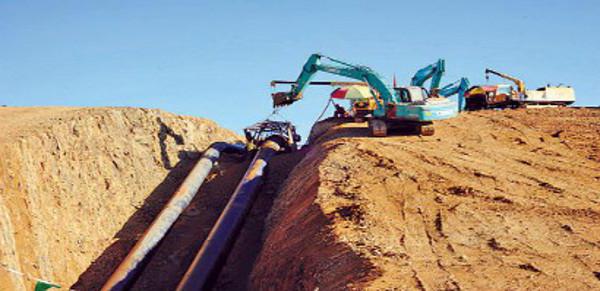
Before laying
Before proceeding with the assembly of the gas pipeline:
- make calculations the required amount in a particular gas settlement;
- determined with the diameter of the pipes;
- are determined with the need for installation of automated control systems;
- make up a project of an external gas pipeline.
The consumers themselves are usually responsible for the assembly of the internal gas supply systems. Boilers and stoves are connected by licensed companies of the corresponding specialization under an agreement with the owner of the house.
Calculation of the required gas
This planning takes into account:
- population and building density;
- absence or presence of hot water supply.
Calculations are made on the assumed maximum values. For example, for settlements with the number of people living from 700 to 2000 and a building density of 150-960 m 2 / ha, this indicator will be 0.7-1.6 m 3 (h · people). In the absence of hot water supply, the estimated maximum flow rate is reduced by 25%. The calculation is carried out taking into account the prospects for the development of a village or city for 10 years in advance.
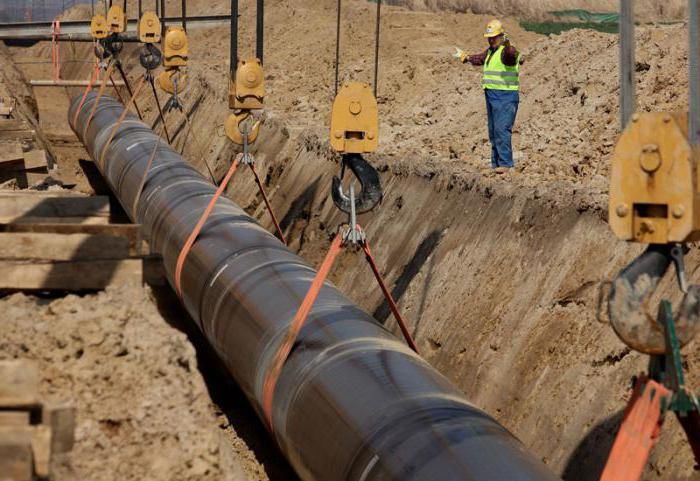
Pipe calculation
The required diameter of the external gas pipelines is selected based on:
- the estimated consumption of "blue fuel" during the hours of maximum consumption;
- pressure loss in the line.
Preliminary calculations of the diameter are performed according to the formula
d = 3.62 * 10 -2 √ Q h (273 + t) / P m v,
where Q h - hourly flow rate at normal pressure, P m is the absolute pressure in the section, v is the gas velocity.
The results obtained are subsequently corrected depending on the resistance in the line (fittings, connections, turns). To determine the pressure drop, special formulas are used (for each gas supply mode - its own).
External gas pipelines arrangement: automated control systems
Such equipment is designed to ensure the highest performance of the highways. Automated WGs) have a centralized structure. Their main elements are:
- controlled points (CP) installed on external highways;
- central control room (upper level).
- gas distribution systems (lower level).
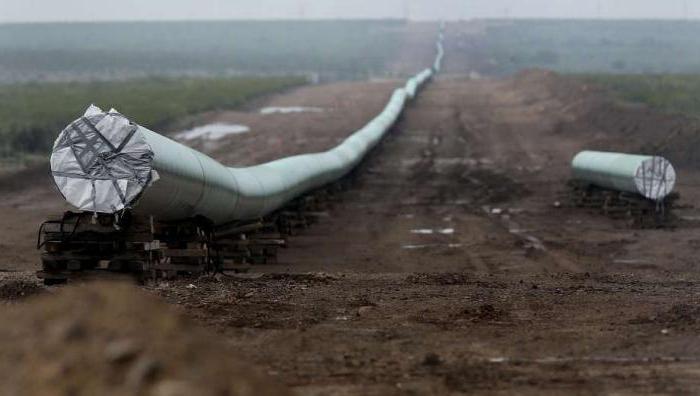
The central control room includes several workplaces, connected by computer networks.Automated control systems of gas pipelines are used:
- for the purpose of operational control of distribution;
- equipment condition monitoring;
- accounting for the flow and consumption of gas.
How highways can be laid
Pulling the gas pipeline is allowed by the underground or overground method. The latest technology is the most economical. The method of laying underground is considered to be safer. This is how gas pipelines are usually pulled through settlements.... However, the implementation of such a technique is more expensive. In service similar the line is also more costly.
Some sections of the network in large settlements can be laid above the ground.But they are almost never too long.Overhead gas pipeline laying foreseen and on the territory of industrial enterprises.
Before n a at the beginning of the installation of the network, its diagram is compiled without fail. The project of the highway, according to the standards, must be carried out in a topographic plan.
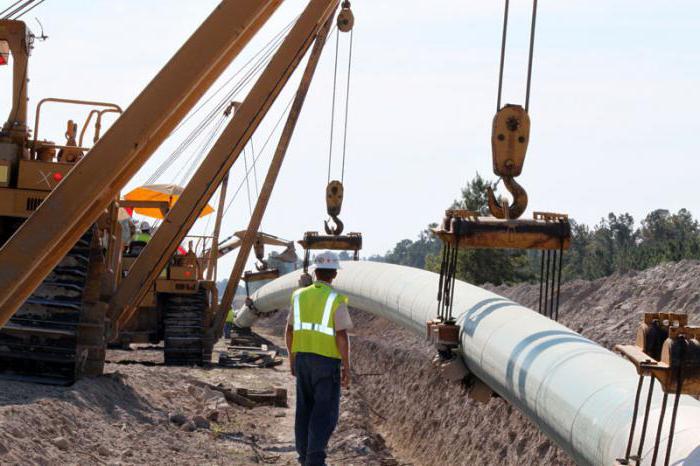
Underground gas pipeline laying: rules
On-site assembly of the gas pipeline is carried out in compliance with the following standards:
- the distance between the gas pipeline and other underground communications should not be less than 0.2 m;
- at the points of intersection with communication manifolds, the pipes are pulled in a case;
- gas pipelines are laid above other engineering systems;
- cases outside the intersection are taken out at a distance of at least 2 m;
- the ends of the cases are sealed with waterproofing materials.
Gas pipeline laying depth dAccording to the standards, it should be at least 0.8 m. But as a rule, trenches for such systems are dug one or more meters. In any case, the depth of the installation should be such that the temperature of the pipe wall does not drop below 15 degrees.
Pipe requirements
The "blue fuel" in underground systems can be supplied via steel or polyethylene pipelines. The advantage of the latter is considered resistance to corrosion and about T relatively low cost. but apply polyethylene pipes for transportationblue fuel "standards are not always allowed. For instance,laying of underground gas pipelinesusing such material is impossible:
- on the territory of settlements with a gas pressure of over 0.3 MPa;
- outside the territory of settlements at a pressure of over 0.6 MPa;
- for the liquid phase of the SGU;
- at a pipeline wall temperature below 15 degrees.
The strength factor of pipes used for laying gas external networks must be at least 2.
Steel pipes for gas can be both seamless and welded. For an underground system, similar lines with a wall thickness of at least 3 mm can be used. It is allowed to use both straight-seam pipes and spiral seams for gas transportation.
Underground highway laying technology
Such systems are assembled as follows:
- marking of the construction strip and geodetic breakdown of horizontal and vertical angles of turns are made;
- excavation works are carried out with a single-bucket excavator with a backhoe;
- manual rework of the trench is in progress;
- the bottom of the trench is leveled;
- pipes are delivered to the site immediately before laying;
- pipes are inspected to detect defects;
- lashes fit into a trench;
- welded and connecting works are performed;
- the gas pipeline is being tested;
- backfilling of the trench is in progress.
It is not allowed to prepare a trench for laying the gas pipeline in advance by the standards. There should not be any stones or debris on its bottom. The pipes are welded in a lash outside the trench. This eliminates the possibility of subsequent leaks. When lowering the lashes, they must not be allowed to hit the bottom and walls.
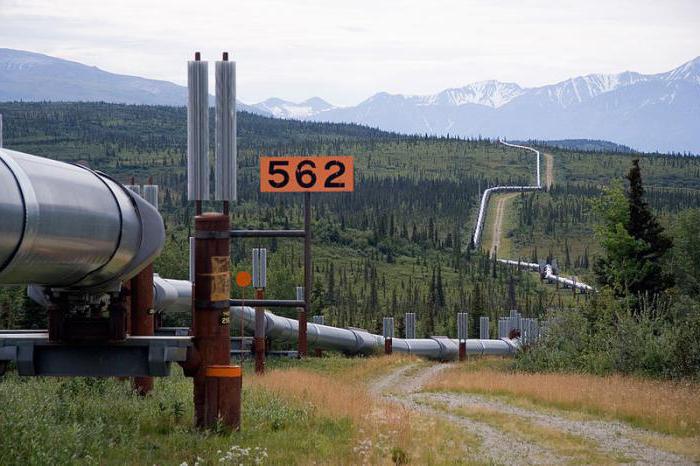
Assemble gas pipelines in winter time year by the standards is allowed. However, in this case, the trench should be dug up to the non-frozen soil. In rocky areas, pipes are laid on a sand cushion. The thickness of the latter should be approximately 200 mm. This eliminates the risk of pipe damage due to contact with stones.
special instructions
Sometimes gas pipelines have to be pulled over problem areas of the terrain. In landslide areas, as well as on soils prone to erosion, the construction should be laid below the limit of possible destruction. The pipes are pulled at least 0.5 meters from the level of the sliding mirror.
Rules for assembling overhead systems
Requirements for laying gas pipelinesof this type the following:
- above the ground, the gas pipeline should be located at least 2.2 m in places where people pass, 5 m - above roads, 7.1 m - above tram tracks, 7.3 m - in those places where trolleybuses travel;
- distance between motionless line supports must be equal to a maximum of 100m with a pipe diameter of up to 30 cm, 200 m - up to 60 cm, 300 m - over 60 cm; Those intended to be installed above the ground must have a wall thickness of at least 2 mm.
M Distribution gas pipelines in small settlements are often laid along supports. The distance between the latter directly depends on the diameter of the pipes. So, for Du-20 this indicator will be 2.5 m, Du-50 - 3.5 m, Du-100 - 7 m, etc.
What is the security zone of the gas pipeline
Engineering systems of this type- explosive structures. Therefore, no construction should be carried out in the immediate vicinity of them. The sizes of the security zones depend on the types of gas pipelines:
- high pressure category I (0.6-1.2 MPa) - 10 meters;
- high pressure category II (0.3-0.6 MPa) - 7 m;
- medium pressure (5-300 MPa) - 4 m;
- low pressure (up to 5 MPa) - 2 m.
Gas pipeline security zoneLPG is usually 100 meters.
According to the standards, once a year, the route is adjusted with the introduction of existing changes in the documentation. In order to mark the security zone of the gas pipeline, special posts are used. They are prescribed to be located at a distance of no more than 50 m from each other. Marked by columns and places of turn of the highway. At intersections with roads and bridges in the security zone, appropriate warning signs are installed. On the highway in such places, signs prohibiting parking are also provided.
Laying gas pipelines indoors
In this case, certain safety standards must also be observed. Produced transit laying of a gas pipeline inside buildings p O the outer surfaces of the walls at a height of at least 1.5 meters from the floor. Sometimes pipes are pulled in channels covered with shields. At the same time, the latter, according to the standards, should be easily removable.Gas pipelines are laid through walls or ceilings in metal sleeves insulated with a non-combustible material.
According to the standards, it is forbidden to pull pipes:
- on door and window frames;
- transom;
- platbands.
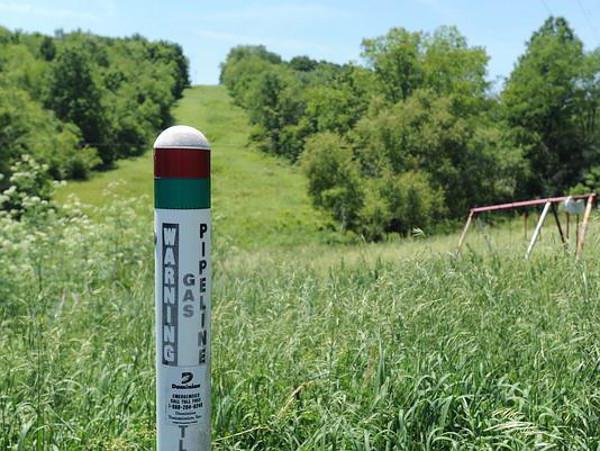
Wooden walls before installation gas equipment next to them should be insulated with asbestos-cement sheets. All joints of the internal gas pipeline are connected by a welded method. Detachable connections are allowed only at the places of installation of shut-off valves.
Steel pipes are usually used to assemble internal systems. But sometimes copper is also used for this purpose. It is not allowed to use such lines only for the transportation of LPG.
Internal connection transit the gas pipeline to the external one and its assembly according to the standards should be carried out only by specialists of a licensed company. After the installation of the system, it is tested and accepted with the signing of the corresponding document.
The construction company "BOSS" provides services to legal entities and individuals for the laying and repair of gas pipelines. We guarantee quality and compliance with standards, since all the norms and requirements of GOST and SNiP are taken into account during the design and installation.
Types of pipelines by purpose and pressure
When drawing up project documentation, the direction and conditions of pipe use must be taken into account: intra-quarter, yard, street or inter-workshop. Operational safety and smooth operation largely depend on pipes that are selected taking into account the pressure (low, medium or high).
During the construction of a gas pipeline, several categories of the pipeline are distinguished:
1.IV - low pressure, total load should not exceed 5 kPa. The main purpose is to supply gas to residential buildings; steel and polyethylene pipes are used during installation.
2.III - medium pressure. The pipes are designed for loads ranging from 5 kPa to 0.3 MPa. The pipeline is designed to transport media to distribution points.
3.II - high pressure. It is allowed to lay a gas pipeline of both steel and HDPE pipes to distribution areas to residential premises and industrial facilities with a network pressure within 0.3-0.6 MPa.
4.I - high pressure. The pipeline is designed for a load of 0.6-1.2 MPa and is designed to transport the carrier to the distribution areas.
5.I-A - high pressure. When laying, a gas pipeline made of steel or polyethylene pipes is used, designed for a network pressure of no more than 1.2 MPa to connect different stations. It should be understood that the construction of a gas pipeline is a great responsibility, since if the design and installation standards are not followed, the danger to the surrounding facilities and people increases.
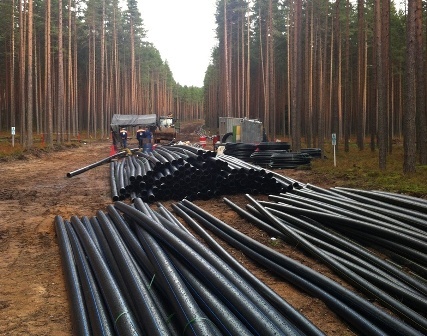
The laying of a gas pipeline can be carried out by an above-ground or underground method, and the pipeline is also classified by purpose:
inter-settlement - the networks are laid outside the cottage settlements and cities;
introductory - a section of utilities from the disconnecting equipment to the internal pipeline;
gas distribution pipelines are laid outside;
internal - the gap of the network from the introductory part to the final consumer.
Our company employs certified engineers, welders and fitters with approvals. All this allows us to carry out the construction of gas pipelines in urban areas, to office buildings, settlements and industrial facilities.
Features of the construction of an underground gas pipeline
Due to the high level of safety, underground laying of a gas pipeline is used much more often than above-ground installation, since engineering networks are protected from the influence human factor, climatic influences and mechanical stress. But here, too, it is required to comply with certain rules on the depth of the pipeline in view of the load from the roadbed and the impact of atmospheric precipitation. The composition of the soil and the level of soil freezing are also taken into account. In the underground construction of the gas pipeline, steel with insulation and polyethylene (HDPE) pipes are used, which avoids the formation of corrosion. HDPE and steel pipes can be combined, since the entry into the building in most cases is carried out with a steel pipeline. With an integral polyethylene-steel connection, the distance from the foundation of the building to the utilities must be at least 2 meters for medium pressure gas and 1 meter for low pressure gas.
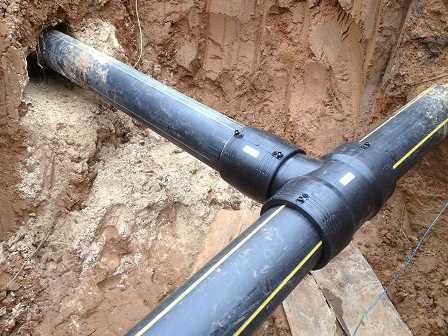
Consider the requirements for the depth of the laying of communications, taking into account the direction of use:
if laying is planned under concrete or asphalt, then the depth should be at least 0.8 m, if there is no hard surface - not less than 0.9 m;
if there is no movement of cars and heavy special equipment on the site, the depth of laying can be reduced to 0.6 m;
for transporting dry gas, it is possible to lay a gas pipeline to a depth of 1.2 m.
When reconstructing, installing and repairing a gas pipeline, we take all safety measures and are guided by regulatory documents PB 12-529-03. A prerequisite is the laying of a warning tape, which further simplifies the maintenance process and warns of the presence of a pipeline with gas. That is, during construction on the site, the excavator receives a clear signal that further excavation is strictly prohibited and dangerous. High-strength polyethylene is used as a material for the manufacture of signal tape, which guarantees a long service life. Peculiarities of laying an aboveground gas pipeline The technology of building a gas pipeline (aboveground or underground) is selected at the stage of development of design documentation.
Above ground installation is most often used under the following conditions:
highly branched underground utilities;
dense urban development;
the presence of irregularities and various obstacles in the form of reservoirs, ravines, etc.;
at industrial and commercial facilities.
When organizing an overhead network, steel pipes are used. The method is characterized by minimal costs for material, work, maintenance and repair of the gas pipeline. But there is a high probability of mechanical damage and this factor requires special attention when developing a project. When attaching the pipeline to houses and buildings, the walls must have certain fire resistance indicators - I-IV degrees, and overlappings - I and II degrees. Fastening of branched sections and valves is carried out on specialized supports. When building a gas pipeline, in accordance with regulatory documents, the minimum height from the ground surface is 35 cm.If the installation is planned to be carried out in places with a large crowd of people, then the height is at least 2.2 m, and on highways and highways for cars - 4.5 m, above By railway communication - 5.6-7.3 m.
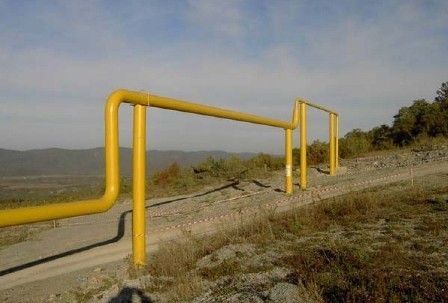
When reconstructing, maintaining, laying and repairing an overhead gas pipeline, we comply with the full list of requirements:
flange connections are removed at least 40 cm from supports and walls;
when attaching communications to the walls of buildings, pipes are used with a design load of up to 0.3 MPa; welds on the pipeline from d to 20 cm are made at least 30 cm from the walls of the object;
upon approval of the project documentation in the relevant authorities, in certain cases, it is allowed to lay a gas pipeline on the same supports with other engineering networks;
the minimum distance from the supports to the roadway must be at least 10 m;
at industrial facilities, it is allowed to lay a gas pipeline of an aboveground and underground type, but it is better to give preference to the second option due to a higher level of safety.
When contacting our BOSS company, you can always get qualified advice on laying a gas pipeline, as well as order a preliminary estimate for free. Working with professionals is always profitable and safe!
When installing gas pipelines, the following basic requirements should be observed:
1) the position of the gas pipeline in plan and profile must correspond to the design one;
2) on the gas pipeline laid in a trench (or laid above the ground), the insulation of the pipe surface must be preserved;
3) butt and other pipe joints must be strong and tight;
4) the gas pipeline must adhere tightly to the natural or artificial base of the trench;
5) the bed under the gas pipeline must be preserved after it has been laid;
6) between the gas pipeline and the crossed underground structures the distances must be maintained in accordance with the standards.
A trench for a gas pipeline is prepared immediately before laying it... The bottom is planned and cleaned of debris, dirt, stones and other objects.
The gas pipeline is laid on a natural or artificial base with whips or sections of separate pipes welded at the edge of the trench. Before lowering the lashes or sections into the trench, they are cleaned from the inside of dirt and scale, close the ends of the sections or lashes with inventory plugs, protecting the pipes from clogging.
Lowering (or other movement of the gas pipeline) is carried out using inventory soft "towels" that do not violate the integrity of the anti-corrosion insulation. The whips or sections are lowered smoothly, without jerking, hitting the walls or the bottom of the trench, without sharp bends of the gas pipeline in the vertical or horizontal planes.
In winter, the gas pipeline is laid on a non-frozen base immediately after the opening of a trench. If the gas pipeline is laid on a frozen base in soils that are not prone to heaving, arrange a backfill with fine sandy soil with a thickness of at least 100 mm.
Under the gas pipeline, laid in rocky and stony soils, they arrange a bedding of soft local or sandy soil with a thickness of at least 200 mm.
Pits for welding fixed joints of a gas pipeline, installing condensate traps, hydraulic locks and others network devices torn off immediately before installation work. The pits are filled up after testing the gas pipeline for strength and checking the condition of its insulation.
Installation of gas pipelines is performed in the following sequence: develop trenches and pits, arranging, if required, drainage; clean up the bottom and walls of trenches and pits; dig pits in the places where pipes are welded and joints are insulated; arrange a natural or artificial foundation for the pipeline; make the bottoms of wells and chambers; lower the pipes into the trench, laying them on the base; pipes are welded, assembling fittings and installing fittings; knock out and sprinkle the pipeline with soil (except for joints); walls and ceilings of wells and chambers are being erected; blow through the pipeline with air; pre-test the pipeline for strength, checking the quality welds and flange connections; insulate joints; fill up the pipeline; the pipeline is finally tested after completion of construction and installation work.
In urban conditions, when it is impossible to keep a long open trench for a long time, pipelines are installed in small sections - grabs. The trench is dug with a length equal to the length of the grapple. In this case, the length of the whip is equal to the length of the grab. Collect and weld pipes in a string outside the trench along the edge, and then with jib cranes or pipe-layers, the string is lowered to the bottom of the trench.
In case of short lengths, it is advisable to install the pipeline using vehicles (installation "from wheels"). Scourges 25-35 m long (by the size of the seizure), prepared at the factory and brought to the construction site by vehicles with a special trailer, are laid by cranes in the trench directly from the vehicles.
Waterproofing steel pipes dispatch... Steel pipelines buried in the ground are susceptible to corrosion due to exposure to the surrounding soil environment. As a result of the action of soil and stray currents corrosion, pipe walls can quickly collapse to their full thickness in a relatively short time.
Methods for protecting pipe metal from corrosion are different.... One of the main methods of protection is coating the outer surfaces of pipelines with anti-corrosion materials. The protective coating must be waterproof, adhere tightly to the pipes, be an insulator against electric currents, strong, capable of resisting mechanical stress (when backfilling trenches and with linear temperature deformations of the pipeline) and at the same time be elastic, capable of not cracking and not softening to runoff during temperature fluctuations.
Anti-corrosion coating of steel pipe surfaces performed mainly in the factory, and at a construction site, insulation is applied only to the joints of welded pipelines that have passed hydraulic or pneumatic test for density and strength, or correct possible damage to the insulation during the transportation of pipes or their installation. Since reworking insulation in a jobsite is challenging work, special care should be taken when handling insulated pipes from the moment of their loading at the plant to laying in a trench, bearing in mind, in addition, that the bituminous layers of insulation do not have significant mechanical strength.
Anti-corrosion coatings are made on the basis of bitumen, polymeric materials, etc.... Bituminous mastics are widely sheltered as protective coatings. The composition of the insulating coating, in addition to mastics, includes roll insulating materials (polymer) and wrapping materials (kraft paper).
Depending on the corrosive characteristics of the soil in which the gas pipeline is laid, the type of insulation is determined: normal, reinforced, very reinforced.
The primer is a mixture of gasoline and bitumen in a ratio of 1: 1.25 by weight or 1: 3 by volume; the primer is manufactured at the factory and delivered to the construction site in a sealed container.
The primer is applied to the pipe surface, previously cleaned of scale, dirt and rust..
Pipes are cleaned mechanically: electric and pneumatic brushes, scrapers, sandblasting machines or manually brushes to a metallic sheen (uniform steel color). Good cleaning of the pipe surface is a guarantee of a high quality anti-corrosion coating.
The primer layer should be even, without gaps, clots, smudges and bubbles.
Under the conditions of a construction site, mastic is prepared in special bitumen-making boilers and applied hot (temperature not lower than 170 ° C) to a layer of dry primer using a watering can, rubbing the mastic from the bottom of the pipe with a towel.
The joints are wrapped with brizol and kraft paper over a hot layer of mastic with an overlap of turns by 20-30 mm. Inner layers can be made without overlap. The winding should fit snugly against the coating without voids or folds.
Installing the lens compensator... The lens compensator is mounted in the well after installing the valve, and then it is connected to the gas pipeline.
The compensator is inspected before installation (the compensator to be installed should not have deformation) and the composition specified in the passport is poured into the lower part of the compensator.
Before installation, the expansion joint is either stretched (at a negative outside temperature) or compressed (at a positive outside temperature). After installing the compensator in the working position, the nuts on the rods are pushed back by an amount that ensures its full compensating ability in accordance with the passport data.
The structure of the wells can be prefabricated or monolithic, but in any case, the wells must be watertight. To ensure the water tightness of wells in soils, waterproofing is used. To do this, the outer walls are pasted over with borulin or plastered with waterproof cement to a height of 0.5 m above the limiting groundwater level.
Prefabricated elements of wells are connected on cement mortar with grouting... During the construction of brick wells, the seams of the masonry from the inside are embroidered and rubbed with cement mortar.
Before laying the gas pipeline in the trench, the bottoms of the wells are arranged, and after the pipes are laid and the fittings are installed, the walls and ceilings of the wells are erected. If a pit is provided at the bottom of the well for collecting water, the slope to it must be at least 0.03. After filling with sandy soil, the sinuses of the wells are watered and compacted layer by layer.
Condensate collectors designed for the collection and subsequent removal of condensate from the gas pipeline, as well as to remove moisture trapped in it during construction, during flushing, etc., are installed at the lower points of the gas pipeline (low, medium and high pressure). Water from gas pipelines enters the condensate traps by gravity. Periodically, water is removed through special pipes, which are also used to purge gas pipelines and release gas during the repair of gas supply networks. The dimensions and design of the condensate traps depend on the gas pressure and the amount of condensed moisture.
Condensate traps are delivered to the facility covered with anti-corrosion insulation... The condensate trap must have a number welded onto the body and be accompanied by a passport, which confirms its compliance with standards and requirements. technical conditions for its manufacture and testing.
An electrode is welded to the tube of the condensate collector, installed in places where stray currents propagate, to measure the potential difference between the ground and the pipeline. A ground electrode is installed in the ground near the condensation tube.
Gate valves with a diameter of 50 mm and more are used as shut-off valves on gas pipelines of all pressures... Gas supply is also regulated with the help of valves. Cast iron and steel valves are used. On gas pipelines with a pressure of 3 kgf / cm2, parallel valves are installed, on gas pipelines of other pressures - wedge valves.
Gate valves on large-diameter gas pipelines are equipped with a worm gear reducer, pneumatic, hydraulic or electric drive. To equalize the pressure, a bypass pipeline is installed on both sides of the valve, which makes it easier to lift the valve.
When installing the valve in the well, it must be borne in mind that there must be free access to it.
Bronze, cast-iron, steel cranes with a nominal diameter of 15 to 700 mm are used in underground and aboveground gas pipelines as shut-off devices. Cranes can be coupling and flanged. The valves are used, as a rule, with a lubricant, which ensures their tightness, resistance against corrosion, and also reduces wear of the sealing surfaces and facilitates turning the plug.
Hydraulic valves used as disconnecting devices on low pressure gas networks. To turn off the gas at the entrance to the building, water is supplied to the hydraulic valve through a pipe. Having filled the lower part of the hydraulic seal, water interrupts the flow of gas through the hydraulic seal and the consumer is turned off. For the subsequent start-up of the gas, the water from the hydraulic seal is removed by blowing.
At the manufacturing plant, the water locks are tested for strength and density, which is noted in its passport. Its surface, including the water inlet pipe, is covered with waterproofing.
Install a water seal on dense soil or sand preparation strictly vertically along a plumb line. The water seal tube, like the ground electrode, is led out under the carpet. The water locks are equipped with devices for measuring the potential difference between the gas pipeline and the ground.
Compensators are used to relieve stresses in a gas pipeline during linear measurements- lengthening or shortening as a result of temperature fluctuations in the ground or changes in the temperature of the gas passing through the gas pipeline. Expansion joint designs are different. The lens expansion joint, which can be single-flanged or double-flanged, is welded or flanged to the gas pipeline.
You may also be interested in:Yard gas distribution. A gas supply to the household is arranged from the street gas distribution pipeline. A valve is installed on the gas inlet at a distance of at least 2 m from the building wall or fence. A courtyard gas distribution is laid from the input with inputs to the stairwells of the buildings.
The input is connected to the street gas main with a tee or a steel pipe welded into the network, and only in some cases - with saddles.
The entrance to the territory of the building site and the courtyard gas distribution of the gas pipeline are arranged from steel pipes laid in the ground at the same depth as the street gas pipeline network. The diameters of the inlets are determined depending on how much gas is consumed. Smallest diameter 50 mm. Pipes are laid with a slope of at least 0.003 towards the outer line.
The distance between the pipes of the gas network and the mains of the water supply system, heating system, sewerage system must be at least 0.15 m vertically, and at least 0.5 m between gas pipelines and electric and telephone cables.
A parallel valve on the gas inlet is installed directly in the ground or in a metal casing. The valve spindle head is brought out to a level with a yard cover and placed in a metal cap. To protect the spindle from damage, a pipe case is put on it.
Gas pipelines made of steel pipes, laid in the ground, must first be covered with insulation to protect them from corrosion.
Separate sections of the pipeline are connected by welding. After pressure testing of the gas pipeline, the welded joints are insulated directly in the trench.
Intra-house gas pipeline network. Gas pipelines inlets to residential and public buildings are supposed to be arranged in non-residential premises accessible for inspection of gas pipelines (stairwells, kitchens, corridors).
Gas pipelines are allowed to be laid in technical corridors and technical undergrounds.
In these cases, technical corridors and undergrounds must meet the following basic requirements: - the height of the premises must be at least 1.6 m, and the width of the free passage must be at least 1 m. hour; - technical corridors and technical undergrounds are prohibited to be used under warehouses... They must have at least two entrances from the outside, not communicating with the entrances to the living quarters, and a gas-tight ceiling; the places of passage of gas pipelines must be sealed.
Pipelines in technical corridors and undergrounds are welded; installation of shut-off valves is prohibited. In this case, the cranes are installed in the premises of the first floor.
When laying a gas pipeline with other communications, it must be located below other pipelines or at the same level with them, and the relative position should be such that it is convenient to inspect and repair them.
Laying risers and the internal gas pipeline network in living rooms is not allowed.
Gas risers are mounted from non-galvanized steel water-gas pipes, threaded or welded. When passing through the ceilings, the risers are laid in sleeves made of cuttings of larger diameter pipes, which are installed with their lower end level with the ceiling. The liners should protrude 50 mm above the floor so that water does not flow into the liner when cleaning the floors. The space between the sleeve and the pipe is partially filled with a resinous strand, and the unsealed space 10 mm wide is poured with bitumen. There should be no threaded or welded joints in the case.
Depending on the location of the apartments, gas risers serve one or more apartments on each floor. A plug valve is installed on each branch to the apartment and a squeeze is installed behind the crane.
Gas pipelines should not cross window and door openings. In places where people pass, gas pipelines must be located at a height of at least 2 m from the floor.
Supports must also be installed at bends, branches and reinforcement.
It is not allowed to lay gas pipelines through ventilation ducts, shafts and chimneys.
The mutual arrangement of gas pipelines and electric wires or cables inside the premises must satisfy the following conditions: - when laying in parallel, the distance from an openly located electric wire or cable to the wall of the gas pipeline must be at least 250 mm; - with hidden laying of an electric wire or laying it in a pipe, this distance can be reduced to 50 mm, counting from the edge of the sealed groove or from the pipe wall; - at the intersection of the gas pipeline with an electric wire or cable, the distance between them must be at least 100 mm.
For residential and public buildings, it is allowed to provide for the intersection of branch wires with a gas pipeline without a gap, provided that the electrical wire is enclosed in a rubber or ebonite pipe protruding 100 mm from each side of the gas pipeline.
The distance of the gas pipeline from the wall of the switchboard or switchboard or cabinet must be at least 500 mm.
Inside the premises, the distance between the gas pipeline and the current-carrying parts of open (bare) conductors with a voltage of up to 1000 V must be at least 1000 mm.
When crossing a gas pipeline with a water supply, sewerage and other pipelines, the distance between the pipes in the clear must be at least 20 mm.
Gas pipelines carrying dry gas can be laid inside a building without a slope.
Gas pipelines carrying wet gas must be laid with a slope of 0.003. If necessary, the gas distribution pipelines laid in the workshops of industrial enterprises should be provided with condensate collectors or fittings for draining condensate.
Gas pipelines at the intersection of foundations, floors, staircases, as well as walls and partitions should be enclosed in cases made of steel pipes.
Gas pipelines passing within the cases should not have butt joints.
The space between the gas pipeline and the case is sealed with tarred tow and filled with bitumen.
The end of the case should protrude 50 mm beyond the building structures.
To turn on individual sections of the network and gas appliances, bronze gas plug valves with conical plugs are installed on the gas pipeline. Cast iron taps are allowed to be installed at the entrance, on branches to apartments from risers located in stairwells.
There is a cutout at the top of the plug valve body for a stud screwed into upper part plug cone and being a limiter. With such a device, the plug can only be turned 90 °. There is a risk at the end of the square head of the plug. When the position of the risks coincides with the direction of the pipe axis, the valve is open; when the risks are perpendicular to the pipe axis, the valve is closed.
Gas network laying





